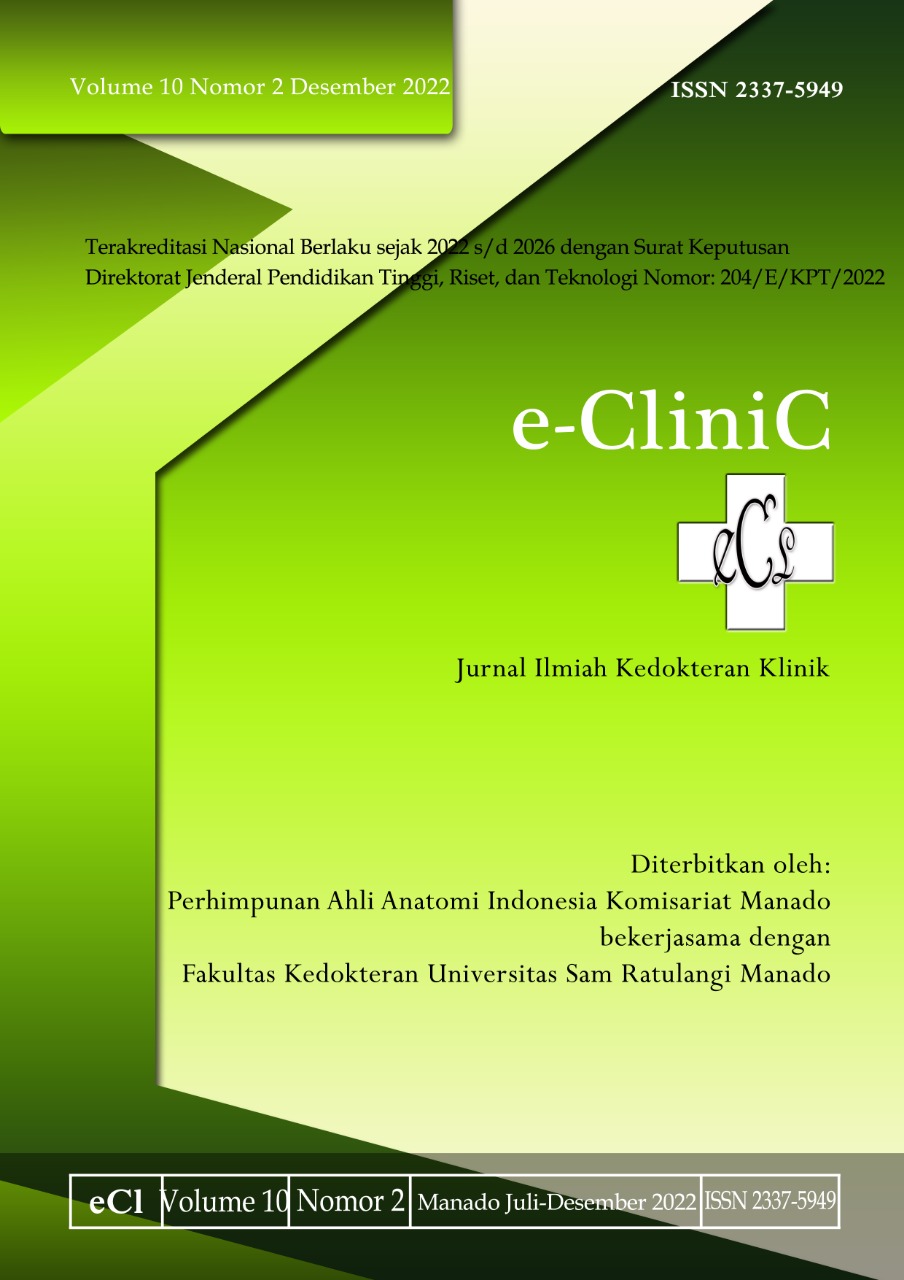Relationship between Serum Fibronectin and Level of Consciousness according to FOUR Score in Traumatic Brain Injury Patients
DOI:
https://doi.org/10.35790/ecl.v10i2.39165Abstract
Abstract: Traumatic brain injuries (TBI) are determined by the severity of the primary and secondary brain damage. Fibronectin and FOUR score are suggested to be diagnostic and prognostic predictors in patients with traumatic brain injuries (TBI). This study aimed to evaluate the relationship between serum fibronectin level and FOUR score in TBI patients. This was an observational study with a prospective cohort method design, conducted on TBI patients admitted to the emergency room at Prof. Dr. R. D. Kandou Hospital. Serum fibronectin examination and assessment of the level of consciousness determined by the FOUR score were performed when the patient entered the emergency room <24 hours. A proportional regression model was used to assess the relationship between serum fibronectin levels and the FOUR score. The results obtained 65 patients, median FOUR score of 13, and 8 patients (12%) with high-risk TBI, median serum fibronectin level of 4 ng/ml, and seven patients (11%) died. The ability of fibronectin as a prognostic factor, especially mortality, did not differ from FOUR score. Logistic regression estimated that serum fibronectin levels >7 ng/ml would increase mortality 33 times and the incidence of mortality increased 23 times. A FOUR score of 8 or less had mortality 34 times and a relative risk of 28 times. In conclusion, there is a significant relationship between serum fibronectin level and FOUR score in terms of stratification of TBI patients. Elevated serum fibronectin level can be used as a diagnostic biomarker and prognostic evaluation of mortality in TBI patients.
Keywords: fibronectin; FOUR score; traumatic brain injury
Â
Abstrak: Fibronektin dan Skor FOUR disarankan sebagai prediktor diagnostik dan prognositk pada pasien COT. Penelitian ini bertujuan untuk mengevaluasi hubungan antara kadar fibronektin serum dan skor FOUR pada pasien COT. Jenis penelitian ialah observasional dengan desain metode kohort prospektif, dilakukan pada pasien COT yang masuk ke IGD RSUP Prof. Dr. R. D. Kandou Manado. Pemeriksaan fibronektin serum dan penilaian tingkat kesadaran ditentukan dengan skor FOUR dilakukan saat pasien masuk ke IGD <24 jam. Model regresi proporsional digunakan untuk menilai hubungan antara kadar fibronektin serum dan skor FOUR. Hasil penelitian mendapatkan 65 pasien COT. Median skor FOUR 13, 8 pasien (12%) COT risiko tinggi (FOUR 0-7), median kadar serum fibronektin 4 ng/ml, 7 pasien (11%) meninggal. Fibronektin sebagai faktor prognostik, khususnya mortalitas, tidak berbeda dengan skor FOUR, regresi logistik mengestimasi bahwa kadar serum fibronektin >7 ng/ml mening-katkan OR mortalitas 33 kali dan insidens mortalitas 23 kali. skor FOUR 8 memiliki odds mortalitas 34 kali dan resiko relatif 28 kali. Simpulan penelitian ini ialah terdapat hubungan bermakna antara kadar serum fibronektin dan Skor FOUR dalam hal stratifikasi pasien COT. Peningkatan kadar serum fibronektin dapat dijadikan sebagai biomarker diagnostik dan evaluasi prognostik mortalitas pasien COT.
Kata kunci: fibronektin; skor FOUR; cedera otak traumatik
Downloads
Additional Files
Published
How to Cite
Issue
Section
License
COPYRIGHT
Authors who publish with this journal agree to the following terms:
Authors hold their copyright and grant this journal the privilege of first publication, with the work simultaneously licensed under a Creative Commons Attribution License that permits others to impart the work with an acknowledgment of the work's origin and initial publication by this journal.
Authors can enter into separate or additional contractual arrangements for the non-exclusive distribution of the journal's published version of the work (for example, post it to an institutional repository or publish it in a book), with an acknowledgment of its underlying publication in this journal.
Authors are permitted and encouraged to post their work online (for example, in institutional repositories or on their website) as it can lead to productive exchanges, as well as earlier and greater citation of the published work (See The Effect of Open Access).







